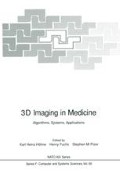Abstract
Methods have recently been developed for using MR data to create 3-D computer models of the gyral anatomy of the brain. This paper describes image processing and computer graphic techniques for using PET images to produce 3-D models of brain surface metabolism. Then, an existing algorithm for retrospective image registration is used to fuse the two constructs into a unified 3-D model of brain structure and function. Neurosurgical planning can benefit from this display technique which localizes PET-detected metablolic abnormalities with respect to MR-defined gyral anatomy.
Access this chapter
Tax calculation will be finalised at checkout
Purchases are for personal use only
Preview
Unable to display preview. Download preview PDF.
References
Herman GT, Liu HK. Three dimensional display of human organs from computed tomograms. Proc Comp Graph Im 9: 21 (1979).
Drebin RA. Volume rendering. Comp Graph 22: 65–74 (1988).
Levoy M. Display of surfaces from volume data. IEEE Comput Graph Applic 8: 29–37 (1988).
Demonstration of Voxel Flinger 3-D imaging system, commercial exhibit at the annual meeting of the Radiol. Soc. of N. America, November, 1989 (Reality Imaging Corporation, Solon, Ohio).
Pizer SM, Fuchs H, Levoy M, et al. 3D display with minimal predefinition. In Lemke HU, Rhodes ML, Jaffe CC, and Felix R (eds): Computer Assisted Radiology. Berlin: Springer-Verlag, 1989, pp 723–736.
Cline HE, Dumoulin CL, Hart HR, Lorenson WE, Ludke S. 3-D reconstruction of the brain from magnetic resonance images using a connectivity algorithm. Mag Res Imag 5: 345–352 (1987).
Chuang KS, Udupa JK, Raya SP. High-quality rendition of discrete threedimensional surfaces. Technical report MIPG 130. Department of Radiology, University of Pennsylvania, July 1988.
Drebin RA, Magid D, Robertson DD, and Fishman EK. Fidelity of threedimensional CT imaging for detecting fracture gaps. J Comput Assist Tomogr 13: 487–489 (1989).
Vannier MW, Marsh JL, Warren JO. Three-dimensional CT reconstruction images for craniofacial surgical planning and evaluation. Radiology 150:179–184 (1984).
Fishman EK, Drebin B, Magid D, et al. Volumetric rendering techniques: applications for three dimensional imaging of the hip. Radiol 163:737–738 (1987).
Kennedy DN, Nelson AC. Three dimensional display from cross-sectional tomographic images: an application to magnetic resonance imaging. IEEE Trans Med Imag MI-6: 134–140 (1987).
Hoehne KH, Riemer M, Tiede U, et al. Volume rendering of 3D-tomographic imagery. In de Graaf CN, Viergever MA (eds): Information Processing in Medical Imaging. New York: Plenum Press, 1988, pp. 403–412.
Stimac GK, Sundsten JW, Prothero JS, et al. Three dimensional contour surfacing of the skull, face, and brain from CT and MR images and from anatomic sections. AJR 151: 807–810 (1988).
Levin DN, Hu X, Tan KK, et al. Surface of the brain: three-dimensional MR images created with volume-rendering. Radiol 171: 277–280 (1989).
Hu X, Tan KK, Levin DN, et al. Three-dimensional magnetic resonance images of the brain: application to neurosurgical planning. J Neurosurg 72: 433–440 (1990).
Pelizzari CA, Chen GTY. Registration of multiple diagnostic imaging scans using surface fitting. In Bruinvis I, van der Giessen P, van Kleffens H, et al (eds): The Use of Computers in Radiation Therapy. Amsterdam: Elsevier, 1987, pp. 437–440.
Pelizzari CA, Chen GTY, Spelbring DR, et al. Accurate three-dimensional registration of CT, PET, and/or MR images of the brain. J Comput Assist Tomogr 13: 20–26 (1989).
Levin DN, Pelizzari CA, Chen GTY, Chen C-T, Cooper MD. Retrospective geometric correlation of MR, CT and PET images. Radiol 169: 817–823 (1988).
Levin DN, Hu X, Tan KK, et al. Integrated 3-D display of MR, CT, and PET images of the brain. Proc Nat Comput Graph Assoc 1: 179–186 (1989).
Hu X, Tan KK, Levin DN, et al. Volumetric rendering of multimodality, multivariable medical imaging data. In Upson C (ed): Proc of Chapel Hill Workshop on Volume Visualization. Chapel Hill, NC: U of N Carolina, 1989, pp. 45–49.
Levin DN, Hu X, Tan KK, et al. Integrated three-dimensional display of MR and PET images of the brain. Radiol 172: 783–789 (1989).
Hoehne KH and Bernstein R. Shading 3D images from CT using gray-level gradients. IEEE Trans Med Imag MI-5: 45–47 (1986).
Ter-Pogossian MM, Ficke DC, Hood JT, Yamamoto M, Mullani NA. PETT VI: a positron emission tomograph utilizing cesium fluoride scintillation detectors. J Comput Assist Tomogr 6: 125–133 (1982).
Serra J. Image analysis and mathematical morphology. New York: Academic Press, 1982, pp. 43, 50.
Hoehne KH, Delapaz RL, Bernstein R, Taylor RC. Combined surface display and reformatting for the three-dimensional analysis of tomographic data. Invest Radiol 22: 658–663 (1987).
Vannier MW, Butterfield RL, Jordan D, et al. Multispectral analysis of magnetic resonance images. Radiol 154: 221–224 (1985).
Koenig HA, Laub G. Tissue discrimination in magnetic resonance 3D data sets. In Schneider RH, Dwyer SJ (eds): Medical Imaging II: Image Formation, Detection, Processing, and Interpretation. Bellingham, Washington: International Society for Optical Engineering, Vol. 914, 1989, pp 669–672.
Cline HE, Lorensen WE, Jolesz F, and Kikinis R. 3D segmentation of brain tissue using connectivity. Mag Res Imag 8 (suppl 1): 155 (1990).
Mosges R, Schlondorff G. A new imaging method for intraoperative therapy control in skull-base surgery. Neurosurg Rev 11: 245–247 (1988).
Vannier MW, Gayou DE, Drebin RA. Applications in diagnosis and reconstruction methods for generic serial sections. Proc Nat Comput Graph Assoc 1: 215–226 (1989).
Author information
Authors and Affiliations
Editor information
Editors and Affiliations
Rights and permissions
Copyright information
© 1990 Springer-Verlag Berlin Heidelberg
About this paper
Cite this paper
Hu, X., Tan, K.K., Levin, D.N., Pelizzari, C.A., Chen, G.T.Y. (1990). A Volume-Rendering Technique for Integrated Three-Dimensional display of MR and PET Data. In: Höhne, K.H., Fuchs, H., Pizer, S.M. (eds) 3D Imaging in Medicine. NATO ASI Series, vol 60. Springer, Berlin, Heidelberg. https://doi.org/10.1007/978-3-642-84211-5_24
Download citation
DOI: https://doi.org/10.1007/978-3-642-84211-5_24
Publisher Name: Springer, Berlin, Heidelberg
Print ISBN: 978-3-642-84213-9
Online ISBN: 978-3-642-84211-5
eBook Packages: Springer Book Archive

